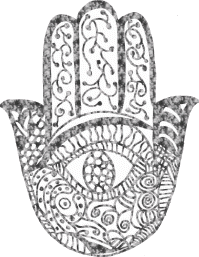
 The
Hamsa and Your Success
The
Hamsa and Your Success
By Yaron Gordon | Submitted On September 19, 2008
The Hamsa is a very interesting symbol used in both Islamic and Jewish culture.
Most commonly, the Hamsa is made in the shape of a hand with five fingers
outstretched. There is, however, the unique Cohanim Hamsa. In this position, the
forefinger and third finger are joined from one side, and the ring finger and
the little finger are joined from the other side. This forms the Hebrew letter
"shin" and is the position of a Cohen's fingers when he blesses the
congregation.
The name "Hamsa" ("Hansa" in Sanskrit, or "Al Khamsa" in Arabic) is from the
Semitic root word for five, and is a very ancient symbol in the Middle East.
Although it is an ancient symbol, the Hamsa is still popular today and is
believed to possess magical powers of protection, happiness and prosperity.
Some say that the Jews were the first to adopt the use of the Hamsa, as a
protective amulet against the evil eye. Jewish lore sometimes calls the Hamsa
the Hand of Miriam, referring to Miriam, the sister of Moses, or it is more
generally called the Hand of God.
The Hamsa hand is also a popular talisman with Muslims, who call it the Hand of
Fatima, referring to the daughter of Mohammed. To the Muslims, the Hamsa
sometimes refers to the five pillars of Islam.
The Hamsa (also spelled "Chamsa" or "Khamsa") is a very versatile symbol and can
be worn as a pendant, can be used as a wall hanging or is sometimes even placed
in a car for good luck and protection from evil.
When trying to decide where to hang a Hamsa you may find a lot of answers, but
the truth is that it is according to your feelings. Hang the Hamsa where you
need its powers of success or where you desire its powers of defense. As well as
being worn as jewelry on your body, the Hamsa can be used as a wall decor in
your bedroom or living room, or you could hang it in your kitchen where everyone
would be blessed, or under the mirror of your car, to bring good fortune and
prosperity.
As to whether it is appropriate to use the Hamsa with the fingers pointing up or
down, it depends upon whether you wish for protection against the evil eye, or
for luck and success. With the fingers pointed up, the Hamsa symbolizes a "stop
sign" to the adversary, in other words, for protection. With the fingers pointed
down, the Hamsa symbolizes God's goodness and blessings coming down to the
wearer or to the room where it is hung. The interpretation of the Hamsa is for
the individual who owns it.
For those interested in numerology, the word "Hamsa" means five, which is a
prime number. The number five is a powerful number symbolizing protection, power
and good fortune. The fifth letter of the Hebrew alphabet is "hey," which means
"Adonai" (God). The word "yad" (Hebrew for "hand," the shape of the Hamsa) has
the number 14. If you take the number 14 and view it as 1 plus 4, it equals 5,
the number for Adonai.
In Chinese philosophy, the number five symbolizes the five senses, five basic
colors and five elemental activities -- Earth, Fire, Metal, Water and Wood, and
it is linked to the "sefira" Geburah, on the tree of life (Kabbalah).
The number five is also represented in the Pentagram (five pointed star) and is
an emblem for defense (The Pentagon).
The Pentagon in Washington, D.C. is a well known five sided building in the
shape of a pentagon. The Pentagon was designed to house the War Department
around the time the United States entered WWII. Ever since it was built the
Pentagon has been a symbol of power and defense for the United States and her
allies.
From this article we can learn about the Hamsa and the connection between the
Hamsa hand, the Hand of God, the pentagram, the Pentagon and the Seal of
Solomon. They are all symbols of the number five, the symbol of power,
protection and success.
Yaron Gordon, the author of this article, is a well known, knowledgeable and
respected owner of a boutique specializing in Judaica gifts. His gallery
includes many hamsas ranging from Hamsa pendant to Hamsa hand for wall décor.
Article Source: http://EzineArticles.com/?expert=Yaron_Gordon